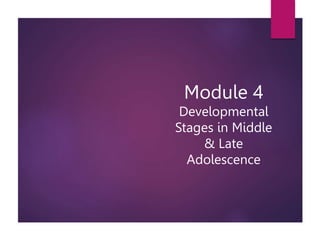
Module 4 Developmental Stages in Middle and Late Adolescence.pptx
- 1. Module 4 Developmental Stages in Middle & Late Adolescence
- 2. At the end of this module, I can: Classify various developmental tasks according to the developmental stage. Evaluate one’s developmental in comparison with persons of the same age group. List ways on how to become responsible adolescents prepared for life
- 3. The Developmental Tasks in Adolescence Robert Havighurst – one of the pioneers in human development studies. According to him, these developmental tasks refer to the specific knowledge, skills, attitudes, and functions that a person needs to acquire and demonstrate at particular periods in his/her life. These are guide to know what is expected of an adolescent during this stage.
- 4. Havighurst identified six major stages in human life covering birth to old age: Infancy & early childhood (Birth till 6 years old) Middle childhood (6–13 years old) Adolescence (13–18 years old) Early Adulthood (19–30 years old) Middle Age (30–60 years old) Later maturity (60 years old and over)
- 5. Adolescence is the period of transition between childhood and adulthood. It includes some big changes—to the body, and to the way a young person relates to the world.
- 6. Developmental Tasks during Adolescence 1. Achieving new and more mature relations with age mates of both sexes; Adolescents learn through interacting with others in more adult ways. Physical maturity plays an important role in peer relations. 2. Achieving a masculine or feminine social role; we need to encourage males to express their feelings and encourage females to assert themselves more than they have in the past.
- 7. 3. Accepting one’s physique and using one’s body effectively; The time of the onset of puberty and the rate of body changes for adolescents 4. Achieving emotional independence from parents and other adults; Children derive strength from internalizing their parents' values and attitudes parents and adolescents should set a curfew time. That curfew extended as the adolescent matures.
- 8. 5. Preparing for marriage and family life; Sexual maturation is the basis for this developmental task. Achievement of this developmental task is difficult because adolescents often confuse sexual feelings with genuine intimacy. 6. Preparing for an economic career; individual completes his/her education and gains some entry-level work experience. 7. Acquiring a set of values and ethical system as a guide to behavior-developing ideology; Adolescents gain the ability to think abstractly and to visualize possible situations. With these changes in thinking, the adolescent is able to develop his or her own set of values and beliefs. 8. Desiring, accepting, and achieving socially responsible behavior. Adolescents and young adults become members of the larger community through financial and emotional independence from parents, which in turn teaches them the value of socially responsible behavior.
- 9. Three Stages of Adolescence Period 1. Early Adolescence happens when you are 12–13 years old. Primary developmental task involves: Adapting to biological and mental development.
- 10. 2. Middle Adolescence around 14 – 16 years old The primary tasks of a teenager are: Achieving new and more mature relations with age mates of both sexes, Achieving a masculine or feminine social role, Achieving emotional independence from your parents and other adults. Further, during the mid-adolescence stage, an adolescent is becoming more adept in social settings and more capable of establishing intimate relationships. 3. Late Adolescence roughly from 17–19 years old At this stage, you should have already formed attitudes, learned skills, and established relationships that will give you bases of ascertaining what kind of a person you are or what kind of life you want to lead.
- 11. Primary tasks includes: Planning and preparing for marriage and family life; Preparing for an economic career; Acquiring a set of values and an ethical system as a guide to behavior or ideology; Desiring, accepting, and achieving socially responsible behavior. Growing up has never been easy. Adolescence is full of of challenges because it is a stage of “becoming” rather than of “being.”